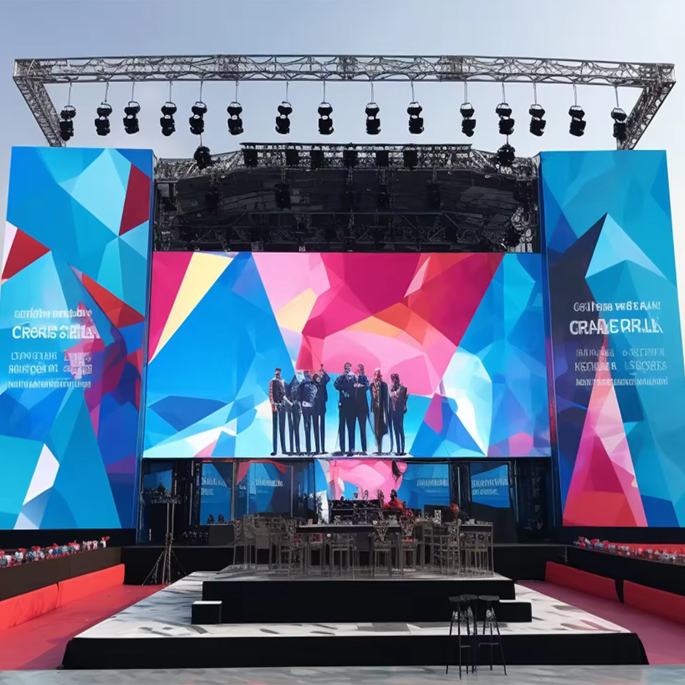
What are the differences between indoor and outdoor LED screens?
Introduction:
Key differences between indoor and outdoor LED screens
Indoor and outdoor LED displays are designed for different environments, which affects their structure, performance, and purpose. The main differences are in their brightness, weather resistance, pixel pitch, and installation methods.
Indoor LED displays are mainly installed in buildings. They have a wide range of applications, such as shopping mall advertisements, information displays, and pillar signs. They generally do not have IP ratings, so they can’t be waterproof and outdoor factors such as sunlight.
Outdoor LED displays are specially designed for outdoor installations. They have a good IP waterproof rating and can be used normally on rainy or snowy days. They also have good weather resistance and can operate stably even in hot weather conditions.

Advantages and disadvantages of indoor and outdoor LED displays
Indoor LED displays Advantages:
Higher Resolution: Indoor LED displays typically have a small pixel pitch, providing high resolution and clear images that are suitable for close-up viewing.
Moderate Brightness: Adequate for indoor environments, reducing glare and energy consumption.
Versatility: Suitable for a variety of indoor applications, such as retail, events, and corporate settings.
Lightweight: Because of its lightweight construction, installation and maintenance are easier.
Lower Energy Consumption: Less power consumption than outdoor displays.

Indoor LED displays Disadvantages:
Limited Weather Resistance: Not designed to withstand outdoor conditions such as rain, wind, or extreme temperatures.
Brightness Limitations: Not suitable for direct sunlight or very bright environments.
Viewing Distance: Suitable for small and medium distance viewing
Outdoor LED displays Advantages:
Waterproof and Dustproof: Designed to withstand water, dust, and extreme temperatures, it is ideal for outdoor use.
High Brightness: Extremely bright to remain visible even in direct sunlight.
Wide Viewing Angle: Designed to be seen from longer distances and wider angles, ideal for outdoor advertising and public information.

Outdoor LED displays Disadvantages:
Lower Resolution: The pixel pitch is large and the resolution is low, making it suitable for long-distance viewing, but not for close-up details.
Higher Energy Consumption: Requires more power to achieve the necessary brightness levels.
Heavier and Bulkier: The structure is stronger and heavier than indoor LED displays.
Indoor and Outdoor LED Displays Applications
Indoor LED displays applications:
Shopping malls: Product promotions and advertising.
Events: Concerts, conferences and exhibitions.
Public places: Restaurants, bars, and churches.
Corporate office: Information boards and meeting rooms.

Outdoor LED displays applications:
Billboard: Highway roadside advertising.
Stadium: Scoreboards and advertisements.
Public square: Information display and advertising.
Transportation hubs: Airports, railway stations, and bus stations.

How to Distinguish Between Indoor and Outdoor LED Displays
IP rating: Outdoor displays have a higher IP rating (e.g. IP65) to improve weather resistance. Indoor displays are usually not waterproof.
Level of Brightness: The brightness of the indoor display is moderate. The brightness of the outdoor display is significantly higher.
Pixel Pitch: The indoor display screen has a small pixel pitch and a close viewing distance, which can display high-quality images and graphics. The outdoor display screen has a large pixel pitch and a long viewing distance.
Physical Structure: Indoor LED displays are usually smaller in size and suitable for indoor enclosed areas. Outdoor displays are larger in size, usually stronger and heavier, and are suitable for installation in open outdoor areas.
Choosing Between Indoor and Outdoor LED Screens – Factors to Consider
Environmental: Evaluate whether the LED display will be exposed to weather factors.
Viewing Distance: Determine the required resolution based on the viewing distance of the audience.
Brightness Requirements: Considering ambient light conditions, it must have sufficient brightness to achieve the required visibility.
Installation limitations: Evaluate the installation location and structural support. Ensure that the installed display poses no risk to the viewer.
Budget: Consider initial costs, maintenance, and energy consumption.
Purpose and Content: Identify the main purpose (advertising, information, entertainment) and type of content.
Durability Requirements: Determined according to life expectancy and frequency of use.
Regulatory Compliance: Ensure compliance with local outdoor installation regulations.
Maintenance Access: The convenience of planning repairs and maintenance, choosing LED screens with low maintenance costs.
Energy Efficiency: Consider long-term energy costs to ensure it operates efficiently and economically.

Conclusion
Choosing the right LED display involves understanding the specific needs of your environment and the technical capabilities of the displays. Indoor LED screens offer high resolution and versatility for close-up viewing in protected environments, while outdoor LED screens provide high brightness and durability for visibility in challenging conditions. By considering factors such as location, viewing distance, and maintenance, you can make an informed decision to ensure optimal performance and longevity of your LED display investment.